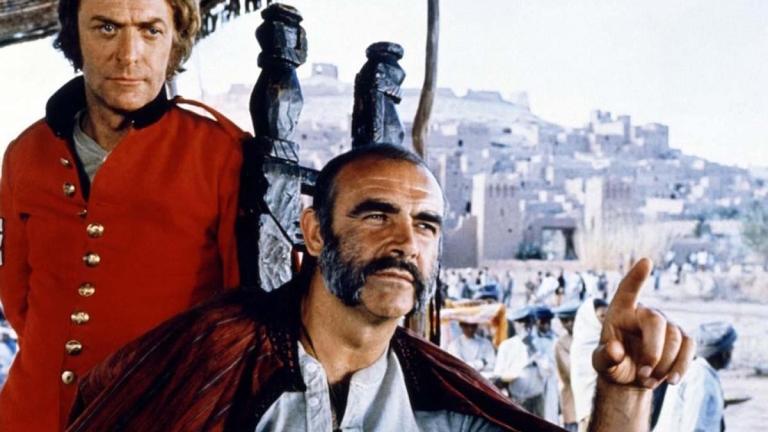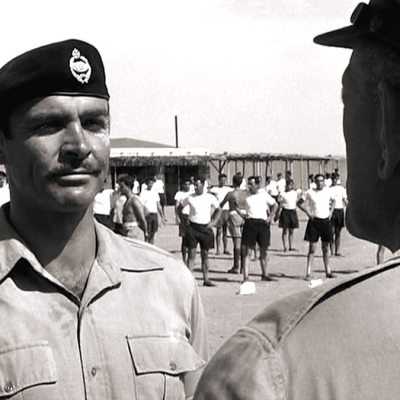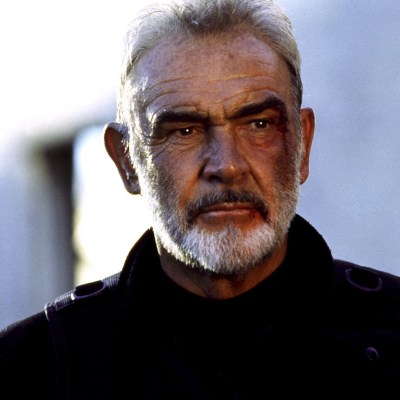Sean Connery and Michael Caine are Godlike in The Man Who Would Be King
Sean Connery and Michael Caine brought the ideal pairing to a film John Huston envisioned for Humphrey Bogart and Clark Gable.

“I’ll stand one day before the Queen, not kneel, mind you, but stand like an equal, and she’ll say ‘I’d like you to accept the Order of the Garter as a mark of my esteem, cousin,’” Sean Connery’s ex-British soldier Daniel Dravot proclaims in the 1975 period adventure film, The Man Who Would Be King. And with those words, and the epic death scene which followed, Connery completed the saga of a long-germinating work from one of Hollywood’s most celebrated directors. John Huston was Hollywood royalty. His father, Walter, was an acting icon, and his offspring have all gone on to distinguish themselves as part of the Huston Dynasty.
Connery was of course no stranger to acting royalty himself. Eventually knighted in 2000, he also got to play King Agamemnon in Terry Gilliam’s Time Bandits in 1981, King Richard the Lionheart in Robin Hood: Prince of Thieves (1991), and King Arthur in First Knight (1995). James Bond was only a small part of Connery’s cinematic output. The Oscar-winning screen legend wasn’t always a suave, debonair, tuxedoed aficionado of the shaken martini.
He was already distancing himself from the immensely popular 007 role by the time he made Diamonds Are Forever in 1971. He wasn’t afraid to get down and dirty for parts, and he reveled in playing the occasional antihero and other less sympathetic roles.
Thus Connery got the chance to play a not-so-bright, morally flawed but timeless character in the 1975 film The Man Who Would Be King. He also fulfilled a lifelong dream for a Hollywood legend, and turned a myth into reality.
Huston had loved Rudyard Kipling’s “The Man Who Would Be King” since he was a child, according to the book The Hustons, by Lawrence Grobel. Kipling was 22 in 1888, when he wrote the short story, and had been shot at while exploring the setting. Huston’s adaptation was a dream project which had morphed into the purgatory of lost film masterpieces, like Stanley Kubrick’s Napoleon, Alejandro Jodorowski’s Dune, or Orson Welles’ Heart of Darkness. Francis Ford Coppola wound up adapting the Joseph Conrad novel with a post-Vietnam War mentality. His Apocalypse Now is about a good man corrupted by absolute power. Huston took the lessons of the unpopular war in the opposite direction. The Man Who Would Be King is about bad men who are held accountable to the indigenous people they conquer.
The Man Who Would Be King is about power, greed and the manifest destiny of entitled Europeans. It lampoons the superiority of British colonialism. In a “Making of” documentary about the film, Huston says he found the “ideal” actors to capture his subversive intent. This movie was the only time Connery played with his lifelong friend Michael Caine, besides A Bridge Too Far, which had too many bridges and a platoon of stars between them. The pair met at a cast party for the first show Connery acted in, a touring company’s production of South Pacific in 1954. On July 9 of that year, Huston told Allied Artists’ Harold Mirish he wanted his next film to be the first and only on-screen pairing of Humphrey Bogart and Clark Gable.
Huston originally had The Man Who Would Be King slated as his next production after he finished Moby Dick (1956). He planned to begin principal photography in India between November 1955 and January 1956 and was negotiating to film in the Todd-AO process. Huston had worked with Bogart on the very first film he directed, The Maltese Falcon in 1941, and the pair continued a string of successful and innovative films together. Though working fairly steadily, Bogart was battling esophageal cancer and ultimately succumbed to it on Jan. 14, 1957. Huston discussed the film with Gable while filming The Misfits, but the actor known as “The King of Hollywood” then also died in 1960.
Richard Burton was set to play the role against Peter O’Toole, and Huston kept start dates ready from January 1966 to January 1967, waiting for the opportunity, but the year passed and it never came. The film almost reunited Butch Cassidy and the Sundance Kid and The Sting’s Robert Redford and Paul Newman, who told Huston the film deserved English actors, and suggested Connery and Caine specifically.
Caine immediately jumped at the role just because his part had been written for Bogart. He’d chosen his stage name after seeing Bogart fidget with his ball-bearings as Commander Queeg in The Caine Mutiny. As for Connery, the Scottish actor captures the essence of Gable’s screen persona in the film. They both bring an amused cynicism toward their roles. Both actors furrow their brows and project a sensual gravitas.
You can imagine hearing Connery say, “Frankly, my dear, I don’t give a damn,” with a different accent but the same delivery as Gable’s in Gone with the Wind. Granted, it would probably be coming out of the mouth of Saturday Night Live’s Darrel Hammond as a bemused answer to Alex Trebek, but it rings true. Whether he liked it or not, Connery’s turn as Bond made him as recognizable in the public’s mind as Gable.
On screen, Caine and Connery interact easily and naturally, nailing the parts with their distinct charisma. Danny and Peachy laugh at their disasters, because there’s really nothing else to do, and they make it infectious. They really are the Butch Cassidy and Sundance Kid of imperialist Great Britain. Caine’s Peachy Carnahan could have been a great-great-grandparent to his Jack Carter in Get Garter; Connery’s Daniel Dravot could imaginably give sage advice to his third-generation thief grandson Matthew Broderick in Family Business (1989), or even lead a son like Indiana Jones across unexplored ancient treasures.
Together, Connery and Caine are a powerhouse. One of the great cinema pairings. They bring authentic accents, real-life camaraderie, and regional humor to the roles. Caine also bought his wife, Shakira, who plays Roxanne, the Kafiristan wife of Connery’s Daniel Dravot in the film. Christopher Plummer played Rudyard Kipling, a correspondent for “The Northern Star” newspaper, and a Freemason, a central point in the film and its symbolism.
Huston wrote the new screenplay with his long-time secretary Gladys Hill. Shooting on the final version took place in Morocco, which traded rough terrain for rampant corruption as the producers had to bribe their way through much of the filming. The locations and local extras were important to Huston to evoke the British Raj period of the movie.
The director wanted Connery and Caine to brave the “mass of mountains and peaks and glaciers” Kipling described in his story. Huston exposed Bogart to the cruel elements of location filming in The Treasure of Sierra Madre and The African Queen, and had discussed parachuting the two Hollywood icons into the Himalayas during the initial production, according to The Hustons. The two British stars faced equal peril. For the climax of the completed version, Huston let Connery plummet hundreds of feet from a rope bridge suspended over a vast valley.
In the film, two former British Army sergeants, now clumsy gunrunners and incompetent conmen, traverse the Khyber Pass to find the isolated area of Kafiristan, located in the Hindu Kush mountains northeast of Kabul, the capital of Afghanistan. This is where the descendants of Alexander the Great live. The Greek emperor had conquered Afghanistan and married a Kafir princess named Roxanne, according to Kipling’s story.
Peachy and Danny plan to become the first Europeans since the ancient Greeks to penetrate the region and “loot it six ways from Sunday.” They admit this to Kipling shortly after robbing him and returning his stolen item back to him.
“In any place where they fight, a man who knows how to drill men can always be a king,” Connery’s Danny explains to Plummer’s Kipling. “We shall go to those parts and say to any king we find: ‘Do you want to vanquish your foes?’ And we will show him how to drill men, for that we know better than anything else. Then we will subvert that king and seize his throne and establish a dynasty.”
With this, Connery’s character captures the eternal dilemma of that region. No external power has ever permanently dominated Afghanistan. Britain lost control in 1919, which the country celebrates as the year of its independence. The Soviet Union invaded Afghanistan in 1979. The U.S. invaded Afghanistan on Oct. 7, 2001, and continues its costly occupation with no end in sight. Kafiristan, which is now called Nuristan, is home to 15 ethnic groups speaking five different languages. No one man can be king. No single government can rule. Even O’Toole in Lawrence of Arabia had to admit that. Connery’s authority, however, has a much deeper voice, and the conviction of a faithful pilgrim.
Peachy and Danny believe they can find a kingdom not yet touched by civilization which they can take over easily with their weapons, knowledge and contemporary expertise. “When we’re done with you, you’ll be able to stand up and slaughter your enemies like civilized men,” they tell their trainees. Huston allows the audience to enjoy the two soldiers of misfortune, in spite of their self-ascribed superiority and blatantly racist attitudes. When their translator asks whether to woo local high priests with claims of their divinity, Peachy says to tell them they are “not gods, [but] Englishmen. The next best thing.”
Danny is nonplussed by how easy the locals are exploited. Connery lets him indulge his moral superiority, tossing harsh judgements on native customs like offering daughters and sons up to guests for sex. When he takes an arrow in the chest and keeps on fighting, he readily assumes his mantle as the son of Alexander the Great. Connery sells that assumption realistically and believably. Peachy assumes the huge rubies in the temple are good to go.
Caine’s Peachy Carnahan remains a Cockney through and through. Connery’s Dravot gives in to temptation almost athletically. When he finds himself worshiped as a deity, he is happy to believe it. The scene where he convinces himself is hysterical, and performed completely organically. Connery is completely surprised by himself, and Caine literally falls over laughing as he does an internal pratfall. It is as much an acting free-for-all as it is a ballet of physical comedy. The gag is the same as C3P0 telling the Ewoks he’s a deity in Return of the Jedi, which happened to be shot on the same Panaflex camera as The Man Who Would Be King.
In a highly competitive Oscar race–which included One Flew Over the Cuckoo’s Nest, Barry Lyndon, and Jaws—The Man Who Would Be King was nominated for four Academy Awards: Best Art Direction, Best Writing, Best Costume Design, and Best Editing. Connery was also the lead performance in the Oscar-nominated film The Wind and The Lion that same year.
The Man Who Would Be King is an adventure film, and Connery and Caine make it a wild ride with perilous curves and a harrowing but hollow finish. Like so many of Huston’s movies, their scheme doesn’t turn out the way it’s planned, but the plot finds strength in the weakness of powerful characters. By the end of the movie, all these two characters have is each other, and even that promises to be fleeting. The performances endure though. It’s acting royalty. It’s like they were destined to do it, preordained.


